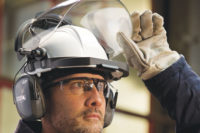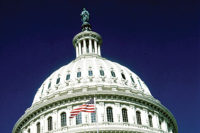To reduce the risk of injuries in high-hazard environments, the ANSI Z87.1 standard calls for eye and face protection to be worn when machines or operations present potential eye or face injury from physical, chemical or radiation agents. A hazard assessment, conducted by the safety manager, is necessary to identify potential eye and face hazards and to specify the need for faceshield use. A wide variety of industries benefit from the use of faceshields, ranging from construction and manufacturing to petrochemical, pharmaceutical, laboratory and forestry.
Even with national safety standards and occupational safety programs in place, faceshield non-compliance is a significant problem. Workers often wear faceshields incorrectly or remove them in the presence of hazards, leaving themselves vulnerable to serious injury. This article discusses some of the challenges involved in using faceshields and how to overcome them, which not only can improve compliance and help reduce injuries, but also can help to improve productivity, profitability and support the safety culture of almost any industry.
Headgear
Workers are most likely to wear faceshields incorrectly — or worse, remove them — due to poorly designed headgear or hard hat attachment systems. When selecting a faceshield, look for headgear that is easy to wear and adjust. Headgear adjustability is critical to achieving a secure, comfortable fit. Flexible and shaped headbands tend to offer individuals a more customized fit, and most individuals find the headband easier to fit with a ratcheting adjustment rather than with pinlocks. In addition to the headband, the user should take the time to correctly adjust the top band on the headgear to ensure a proper depth setting. This often overlooked adjustment is important for the stability of the faceshield and can make a big difference in comfort and safety. This adjustment needs to be made only once unless the headgear is shared with others. When worn properly, headgear should sit between half an inch and one inch above an individual’s eyebrows.
Visor options
Faceshield visors — also sometimes referred to as “windows” or lenses — come in a variety of shapes, sizes and materials. National safety regulations generally do not mandate the amount of coverage required for specific hazards. Therefore, it is up to the safety manager to select the appropriate amount of coverage for the specific application. Wider faceshields provide the best protection from the periphery, while smaller shields are great lightweight options for intermittent protection from hazards directly in front of the user. In environments where the chemical or impact hazard is regularly below the wearer’s neck, a chin guard is required.
There are three common types of visor material — polycarbonate, propionate or acetate —each with its own set of characteristics. Check the manufacturer’s specifications to determine the best material for the hazard. Also, consider the fact that workers are proven more likely to remove PPE when they experience eye strain or fatigue. Molded propionate and polycarbonate visors offer superior optical quality and help reduce issues associated with eye strain. Visors with advanced coatings that resist scratching also lessen eye fatigue and in turn help support compliance. Molded and shaped visors have additional benefits. They are easier to mount correctly, thereby reducing the chance for unintentional visor ejection which could lead to an injury.
How the visors attach to the headgear is another important consideration. Some visors come with universal mounting holes, which are a set of seven strategically located slots designed to fit a wide variety of headgear and brackets. While universal visors fit most headgear, to get the optimal fit and to avoid compatibility issues, it is best to use the headgear manufacturer’s suggested visor.
Combination use
Faceshields are frequently used in combination with other protective equipment, such as hard hats, respirators or hearing protection. Since they are a secondary form of eye and face protection, faceshields must always be worn in conjunction with protective spectacles or goggles. When selecting primary eye protection, low-profile spectacles and goggles work best, providing the greatest comfort and the least interference with the faceshield. It’s very important to note that not all styles of head and face protection are easily combined, however, and careful attention should be given to ensure that interaction among PPE be minimized.
Properly combining faceshields with hard hats is one of the most common challenges. If using a faceshield in conjunction with a hard hat, keep in mind that adapters/attachment systems must be compatible with the companion hard hat. This ensures there are no large gaps between the hard hat brim and the faceshield bracket, which would allow hazards to enter into the facial area. Choosing an integrated system from a single manufacturer or a universal mounting system will help to ensure proper attachment.
While every product combination cannot be covered here, it is important to look for PPE systems that can be quickly and easily adjusted for fit, comfort and safety without removing the faceshield. In applications where workers frequently switch activities and PPE, look for an attachment system that simplifies that transition and allows for faceshields to be easily donned (worn) and doffed (removed) without removing any other PPE. This enables a quicker, safer transition — from a welding helmet to a faceshield, for example — without leaving the work area or exposing a worker to risk. When adjustment mechanisms require the user to remove the faceshield or other PPE, he or she must first exit the hazard area. This wastes valuable work time and reduces productivity. Ease-of-use in switching head protection increases productivity since the worker does not have to leave the workplace. It also increases worker safety because it eliminates the risk of workers removing PPE in the presence of hazards. By selecting faceshields with simple adjustments and quick-switching mechanisms, one can achieve maximum safety and productivity.
Employers and employees alike have a great deal to gain by utilizing the full-face protection that faceshields deliver. However, the improper usage of faceshields is widespread and poses serious safety hazards to individuals across a myriad of industries. As with any PPE, a faceshield is most likely to be worn correctly if it is comfortable and performs at a high level. By selecting the right faceshield for the application and teaching workers how to use it properly, companies can support a successful culture of safety — and the resulting benefits are invaluable.
SIDEBAR
|
2010 ISEA/ANSI guidelines: The standard for eye & face protection |
| By Peggy Kroesch and Jim Katz |
|
According to OSHA’s website, “Thousands of people are blinded each year from work-related eye injuries that could have been prevented with the proper selection and use of eye and face protection. Eye injuries alone cost more than $300 million per year in lost production time, medical expenses, and worker compensation.” To reduce injuries, the International Safety Equipment Association (ISEA) announced that the American National Standard Institute (ANSI) approved and issued ANSI/ISEA Z87.1 – 2010 American National Standard for Occupational and Educational Eye and Face Protection (ANSI Z87.1-2010). The standard went into effect April13, 2010, and is an update to the 2003 standard. Safety eyewear products that meet the updated standard must provide proof of protection against specific hazards related to optical radiation, impact and coverage, droplet and splash, dust/fine dust and head size. It is now imperative for any manufacturer of personal protective equipment to assess all possible workplace environmental risk and provide tangible technological solutions within the parameters of these guidelines. Employers need to consider the following: 1. How can I best select protective safety eyewear based on the hazards present in the plant? 2. Head sizes vary — what products provide the maximum protection, performance, comfort and style available to my employees? 3. How can I select the best lens technology appropriate to the environment, e.g., high pressure sodium lamps, metal halide/mercury vapor, fluorescent or LED? The answer: select protective eyewear products that meet or exceed the ANSI Z87.1 – 2010 standards and are marked as such. |



